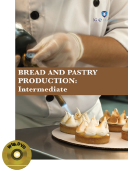Hotel and Restaurant Management

Bread and Pastry Production: Intermediate combines many different practical and visual skills with knowledge of specialized materials and techniques. Pastry is a major type of bakers’ confectionery. It includes many of the various kinds of baked products made from ingredients such as flour, sugar, milk, butter, shortening, baking powder, and eggs. Small tarts and other sweet baked products are called pastries. Pastry is differentiated from bread by having a higher fat content, which contributes to a flaky or crumbly texture. This book will introduce the knowledge and skills for those studying and/or working in bakery industry.
About this Book
The information in this book covers basic to core competencies that person must achieve to be able to clean equipment , tools and utensils and prepare, portion and plate pastries, breads and other dessert items to guests in hotels, motels, restaurants, clubs, canteens, resorts and luxury lines/cruises and other related operations.
About the Bread and Pastry Production Industry
Despite growing at a relatively sluggish pace, baked goods still continues to offer growth opportunities for manufacturers and retailers alike. Catering to indulgence trend in the some of the fastest growing markets in the world, pastries stand out as the biggest contributor to global growth. Pastries is the fastest growing category among baked goods, accounting for almost 80% of absolute volume growth over 2008-2013. Product innovation and increased penetration in fast growing regions such as Asia Pacific and Latin America are the main drivers of this increase. In 2013, Asia Pacific generated over 60% of global baked goods growth. With burgeoning populations and low per capita consumption, China accounted for the majority of this growth, driving volume sales of pastries, in particular. Bakers produce various types and quantities of breads, pastries, and other baked goods sold by grocers, wholesalers, restaurants, and institutional food services. Some bakers create new recipes. Commercial bakers commonly work in manufacturing facilities that produce breads and pastries at high speeds. In these facilities, bakers use high-volume mixing machines, ovens, and other equipment to mass-produce standardized baked goods. Commercial bakers often operate large, automated machines, such as commercial mixers, ovens, and conveyors. Retail bakers work primarily in grocery stores and specialty shops, including bakeries. In these settings, they produce smaller quantities of baked goods for people to eat in the shop or for sale as specialty baked goods. Retail bakers may take orders from customers, prepare goods to order, and occasionally serve customers. Although the quantities prepared and sold in these stores are often small, they usually come in a wide variety of flavors and sizes. Some retail bakers own bakery shops or other types of businesses where they make and sell breads, pastries, pies, cupcakes, and other baked goods. In addition to preparing the baked goods and overseeing the entire baking process, they are also responsible for hiring, training, and supervising their staff. They must budget for and order supplies, set prices, and know how much to produce each day. Most retail bakers are also responsible for cleaning their work area and equipment and unloading supplies.